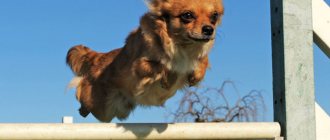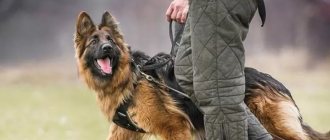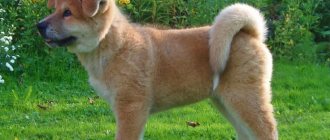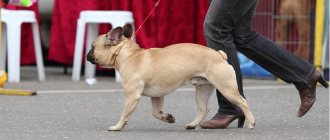Features of behavior and character
The character of a spaniel can be different, which is explained not only by its varieties, but also by the conditions in which it is placed after the kennel. Whether it is an English, Russian or American cocker spaniel, there are certain rules: in order for a dog to grow up as a friend and helper, in addition to daily activities and regular training, it needs human care, attention and affection. Despite their physique, spaniels have an active and playful character.
Being on a wave of positivity, they need timely training, otherwise they risk becoming stupid.
Spaniels are very friendly and inquisitive. They strive to be in the company of those who care for them, love them and feed them. In the absence of proper attention and with long loneliness, they are characterized by destructive behavior. Therefore, the breeder of these dogs must have enough time so that he can raise his pet to be a good friend and faithful companion.
Dogs of this breed are characterized by a willingness to please their owner. This trait can be taken as a basis for education and training, making it easier to conduct classes. Dogs understand what is needed from them; they subtly sense the intonation of the voice and the manner of speech. They have excellent adaptability, patience, and energy.
But, along with advantages, character also has negative sides. For example, animals can be stubborn and independent. The dog can weigh the relevance of each command given, considering whether it is really worthy of execution.
If training is improper, the pet takes on the role of a teacher and often manipulates the owner.
At what age should you start parenting?
As a rule, puppies are taken from the nursery at 2 months. At this time, they are already familiar with such a concept as socialization and have a stronger psyche. Two-month-old puppies are active, learn to play with each other, stand well on their paws, run a lot and are constantly moving. Considering that the period of adaptation to a new place and owner can last 6-7 months, the sooner the puppy is adopted, the better.
However, experts recommend picking up a puppy no later than three months.
This is explained by the fact that at a later age the dog will not be particularly willing to strive for training and education. Moreover, the speed of learning may slow down, waywardness and persistence may appear. So, the minimum age for starting training is 2 months, the maximum is 3.
The subtleties of raising a puppy
They begin raising the baby immediately after he appears in the house, choosing a day off for this. If you give him a lot of time to adapt, you may miss the time to stop the wrong behavior. In the first days, you can put a heating pad or a small fur mattress in the bed. Under no circumstances should a puppy be placed in a human bed. The puppy is accustomed to its place from the first day of its stay in the new home.
To do this, pat the litter with your hand and say the word “place.” Along with this, the baby begins to accustom himself to his nickname. This is an important step on the path to training, because first the dog must learn to understand when the owner is addressing him. On the very first day, you can wash the puppy so that he can dry and run around until the evening. Then it is washed no more than once a month.
The owner feeds the puppy, he also walks, pets, communicates and plays when the baby requires attention.
However, you cannot pamper your spaniel too much, since during the training process the dog understands that there are times when the owner cannot pay attention to it.
There should be no raising of the voice, as well as shouting, in communication and education. The paws and belly are wiped after each walk and washed if necessary so that dirt from the street does not enter the rooms of the house.
It is especially important for the baby to take care so that he does not feel lonely after separation from his mother dog. Call the puppy by name during games, pet it and talk to it. They buy toys for the baby, play with him, while talking to him and calling him by name. As you understand, you can teach the puppy basic commands, such as “no”, “fu”, “come”. In the first months of life, when pronouncing a command, there should be no unnecessary words and huge tirades: the pet simply will not understand what is required of it.
Along with accustoming him to a nickname, his own place and some simple commands, the owner must regularly carry out hygiene procedures. You should not allow the puppy to walk around dirty in the house; you need to clean its ears, comb its fur, and take care of the condition of its teeth. If you teach your child hygiene from childhood, it will become the norm for him, and therefore he will not be nervous during it.
If during play your pet grabs an object with its teeth, you should not pull it out by force.
You can’t keep a spaniel on a leash all day, the baby can break the chain, whine and complain in his own way, which will bother all the neighbors. In addition, he can become aggressive, which can turn into a parenting problem.
At first, a dog living in an apartment building will have to be carried for a walk in your arms. Someone uses a backpack for this, and the puppy quickly understands that he is going for a walk as soon as he sees the backpack in the hands of the owner.
Characteristics, description, character
Males of the English Cocker Spaniel reach a height of 39-41 cm, and females - 38-38 cm. Their weight can fluctuate between 12.5 and 14.5 kg. Dogs live 14-16 years.
The English Cocker Spaniel, whose character fully matches his appearance, is playful, cheerful, responsive and friendly. They do well in large families and get along well with single people. Even if several people live with him, the dog will have a strong attachment to only one family member.
Sociability and friendliness towards strangers is something that is characteristic of cockers. Not being guard dogs, they are friendly even to strangers. But some dogs may be timid, shy, and have a strong attachment to their owner, when the pet is very dependent.
Even as a pet, he remains an excellent hunter, he has an excellent sense of smell and eyesight, and during walks the English Cocker Spaniel shows his partiality for crows, pigeons and other birds that come his way.
He wants to be liked by others, his constantly wagging tail indicates that he is happy from being in his favorite environment. The Cocker Spaniel is smart, easy to train, and has no equal in games where you need to search and fetch. His passion is field hunting.
If you have chosen a cocker spaniel as your future pet, whose character can be described as sensitive, you will have to restrain yourself from showing negative emotions, since the dog is sensitive to screaming, physical punishment should never be applied to it. Love and strict kindness is exactly how you should treat this breed.
The dog's body resembles a square, so its height at the withers is approximately equal to the length of the body. The dog has a rectangular muzzle, a wide nose, and eyes of different shades of brown. A healthy dog has a cheerful, good-natured, intelligent look. The long ears are located on the sides of the head at eye level and are completely covered with long, silky hair.
We suggest you read: Why does a cat bite her little kittens?
The Cocker Spaniel has a strong, robust body with well-developed muscles. His movements are fast, dexterous, and swift.
The dog's coat is long and soft, it does not curl or curl. Representatives of the breed are characterized by different colors: black, spotted, chocolate, sand, fawn. If the dog has a solid color, then there should not be any markings of a different color, otherwise this is a fault.
Those who have ever interacted with a Cocker Spaniel will understand that this is the sweetest dog, which is a pleasure to have as a pet.
How to train a dog correctly?
When the spaniel is 3-4 months old, it must be trained to the “near” command. In addition, at this time it is time to teach your pet the commands “stop”, “show teeth”, “collar”. At this time, the baby understands the hours of meals if the owner feeds him on time. For education and training to be successful, several key rules must be taken into account.
- Everything has its time. If you shift upbringing and training from day to day, blaming everything on lack of time, you won’t be able to raise a dog.
- Regularity. It is necessary to train your pet every day so that the animal can consolidate its skills by learning the norms of behavior.
- Moderation of load . You cannot mix several commands at the beginning of training, as the pet will confuse their meaning.
- Patience. If the child follows the command correctly, he must be encouraged; if he cannot learn the lesson, you must not raise your voice at him or offend him with lack of attention.
- Game approach. Spaniels are cunning animals, and therefore they can quickly get bored with monotonous training. Without a creative approach, they will get bored and try to take the parenting initiative into their own hands.
- Personal contact. You should not delegate upbringing and training to someone else, because personal communication is the key to a trusting relationship between the dog owner and the pet itself.
How to train a spaniel? Tips from dog handlers
Raising and training a spaniel should begin as early as possible - from 2-3 months. A hunting dog must know only its owner, distinguish his voice and carry out only his commands.
Try to do without outside services to train the dog, otherwise he may get used to the instructor’s voice and not respond to your commands. During the period of memorizing the nickname, the puppy should be in pleasant, comfortable conditions - during play, stroking, walking, so that it is associated with pleasant events.
The place that will be allocated for the puppy’s permanent residence must be permanent, located away from the passage and closed from sunlight. It is best to make some kind of house from a cardboard, plywood or wooden box measuring approximately 50 x 60 x 50 cm with a small hole and a removable lid.
In the habitat of a two-month-old puppy, if this age occurred during the cold season, a warm rubber heating pad should be placed under the bedding while sleeping. If the baby wakes up and is playing, take it away so that he doesn’t chew it. The “sit” command should be accompanied by a raised hand; over time, the dog will respond to this gesture in the same way as to a voice command.
When training your dog, do not overdo it with commands. Because he may get tired of it, and he will stop perceiving science. When practicing the “come to me” command, you should simultaneously use a whistle, because at long distances a whistle is much more convenient.
General recommendations
Spaniel training at home is hard work that does not tolerate inattention and letting the situation take its course. During training, the dog must learn not only to carry out any commands spoken by the owner. She must also understand and stop certain actions on the owner's command.
The training can be based on the training of I.P. Pavlov , which allows you to develop reflexes taking into account conditioned and unconditioned stimuli. The trainer can influence the dog using different techniques, for example, encouragement or prohibition. To turn a reward into a conditioned stimulus, you need to connect it with some kind of treat. With frequent rewards, the dog will quickly understand what is required of it, and this technique will have a beneficial effect on its attachment to its owner.
It is useless to force a spaniel to train. Neither a tug on the leash, nor a blow with a rod, nor a threatening intonation will make the spaniel obedient and flexible. On the contrary, they will be the reasons for the dog’s insecurity and fear of the owner. To prohibit your pet from doing something, just say the command “no”. Of course, at first it will not be easy to get used to the same leash or collar.
However, rather than screaming and hitting the animal, it is more advisable to come up with a more positive way to train it.
You should not jerk the collar sharply, even if your pet really wants to run away and explore the world around him.
By doing this, the owner shows superiority, but this does not contribute to proper relationships. The teaching principle should be based on team unity, action and encouragement.
For example, the “sit” command is taught by light pressure on the puppy’s croup. As soon as the pet sits down, he is praised and encouraged. The “take” command is taught during one of the feedings. Food is given to him on the command “take”, thereby teaching him patience, because the dog must understand the order. Otherwise, for example, when hunting, she may rush after the game ahead of time.
The “no” command begins to be practiced from the “young claws”, at the bowl. In this case, food is given with the command “take” so that the puppy understands that he is allowed to eat. At the initial stages of teaching the “no” command, you can use a leash. In the future, it is removed, trying to avoid physical impact. The “come” command is considered one of those that puppies get used to faster than others.
You can accustom a puppy to it in literally a month using reward techniques. You can invite him to your place by treating him to some delicacy. However, when calling your pet, you must remember and follow the order of actions. First they give a command, then they show a treat and only after that comes reinforcement. When training, you can use a whistle: it will serve as a kind of signal to carry out the command.
For more information on training a spaniel, watch the video below.
Commands “no”, “take” and “sit”
When training a spaniel for use in hunting, the “no” command is very important, when the dog needs to be calmed, called to order, and restrained from some actions that could interfere with the hunter and frighten off the game prematurely. This command is also very relevant in everyday life to teach your pet to behave correctly and not do prohibited things. Training should be carried out during feeding, placing the puppy in front of a bowl of food and keeping him from starting the meal, saying “no”. After a while, give the command “take” and open access to food. Spaniels learn these commands quickly.
Another simple but important command is “sit”, to which the puppy is taught by light pressure on his croup synchronously with the pronunciation of this word. Having completed it, the puppy receives a treat and praise.
Training a Cocker Spaniel Puppy, When to Start
Training an American Cocker Spaniel puppy must begin from the very first days.
the presence of a dog in your home. There is an opinion that puppies should be trained no earlier than 6 months, but this opinion is erroneous, although quite widespread. From infancy, you need to instill in your dog the rules of behavior in your home, what is allowed and what is prohibited.
Often new puppy owners worry that training from the first days will be excessively stressful for the dog. This is only possible if outdated rigid methods are used, and with the right approach, training from the first days will be, on the contrary, very useful, since it allows you to immediately establish contact
with the puppy and build a trusting relationship.
Raising a 2 month old Cocker Spaniel puppy
At 2 months old, your American Cocker Spaniel puppy is still at home, in quarantine after the first vaccinations, and he is not yet allowed to go for walks. Therefore, it’s time to start raising a puppy in familiar home conditions.
The first step is teaching the puppy to go to the toilet in a diaper . At the same time, it should be remembered that any learning is a rather complex thing, and when you see the first positive results, you should not think that your puppy has already understood everything, but you should continue training according to the method, so that after a while you do not have to start all over again.
The second important point will be to accustom the puppy to a collar and leash . Yes, yes, this should be done at home, so that by the time the puppy goes outside for the first time, wearing a collar will not be additional stress for him, but is already a familiar thing, and he can begin to explore the world around him, rather than trying get rid of an unknown object.
The third point, which causes the greatest difficulties for new puppy owners, will be the definition of the puppy’s boundaries of what is permitted :
- Teach to play only with your toys, and not with your things;
- Explain that you cannot bite your hands even in a game;
- Establish the correct daily routine, establishing the rule that in the morning you need to sleep and not wake you up;
- Stop chewing furniture, clothes, walls and baseboards;
- Teach to stay home alone, knowing that your absence is not a reason to bark or howl.
"Give it to me!"
To accustom a puppy to serving game while hunting, you should first teach him to bring food to his owner. A diarrhea is a thing that a hunting dog carries in its teeth. At the beginning of training, you can use a regular ball or a soft cloth toy. After fastening, it is worth moving on to a piece of wood, which can first be wrapped in fabric. Later on the hunt, you can use the shot game for training.
How to train a husky? First, you need to play with the dog for some time. Then attract the dog's attention by dragging him and throw him forward. As soon as the animal takes the toy into its mouth, you need to use the “near” command. The diarrhea should be removed from the dog’s mouth with the command “give.” For following a command, your pet should be rewarded with a treat.
We suggest you read: What flavors does bream like?
Further, the playing time before training must be reduced. The diarrhea should be thrown over a greater distance. The dog must be taught to sit down when it brings diarrhea and wait until the owner takes the prey. To do this, when the dog returns with diarrhea, you need to give the command “sit”. After a few seconds, you should take the toy away and reward the dog. You should gradually increase the period of time after which the diarrhea is removed from the animal.
Socialization of a Cocker Spaniel puppy at 3 months
Three months is an important stage in introducing an American Cocker Spaniel puppy to the outside world. Your first walks should be short and not too tiring for the puppy.
At this age, the puppy’s nervous system is forming.
, so it is necessary to show him as much as possible: noisy streets, large crowds of people, etc. This must be done very carefully, gradually, over and over again increasing the time spent in noisy places, so as not to overload the puppy and not frighten him.
It is also necessary to introduce the puppy to friendly dogs and people.
so that later the puppy does not develop aggression or cowardice caused by the fear of new things and the inability to communicate and make new acquaintances. And this is currently, unfortunately, not uncommon in the behavior of adult dogs, but a fairly common problem with which people turn to our specialists for help.
The emergence of new places leads to new rules that need to be consolidated:
- Now you can and should go to the toilet on the street, rather than steadfastly endure and carry everything home;
- Not every new person or dog wants to communicate, so you don’t need to run headlong to meet everyone;
- Not all food is healthy, so it should only be taken from the owner’s hands.
Training a puppy follows the same principles as at 2 months. It should be remembered that at this age puppies develop conditioned reflexes quite easily, but they are also quickly forgotten, so you should not scold the puppy for not following commands, especially if they have not been repeated for a long time, but you should pay more attention to learning new things and repeating already learned material .
Features of training an English Cocker Spaniel
A dog of this breed has a good combination of intelligence, kindness and cunning. His attachment to his owner is explained not only by the desire to gain approval, but also by the understanding that, together with their owner, they form one whole.
Spaniels easily get along with other dogs and all kinds of pets, be it a cat or a canary.
Spaniels of the English breed are kind, affectionate, smart and cunning! This is actually a dog with a wonderful character, but... be careful: he is willful and always on his own mind.
It is for this reason that it is recommended, especially from a very early age, to be the strictest possible teacher for him and in no case follow the lead of your four-legged pet. Otherwise, the dog will realize that you are somewhat soft towards him, and will regularly use this to achieve one goal or another.
To achieve effective training, it is important to adhere to the following recommendations:
- Give your animal more time. Training should be carried out regularly.
- It is best to start introducing your puppy to society as early as possible and only after he has all the necessary vaccinations.
- English cocker spaniels are hunting dogs, so it is necessary to provide your four-legged friend with the proper level of exercise, such as jogging or walks in the park.
- Show more persistence and patience during training.
- The best way to train is through play. Thanks to this approach, the pet will not be frightened by its owner, and, therefore, its psyche will not suffer. And yes, under no circumstances should you yell at your dog.
- Reward the animal for correctly performing an exercise or command.
- Training is an integral part of the life of dogs of this breed. If, due to some circumstances, you cannot cope with this task, then it is best to seek help from a qualified dog handler.
- If you want to maintain contact with your dog, it is not recommended to shift your responsibilities for caring for and training a young cocker to another person.
As already mentioned, English Cocker Spaniels are hunting dogs, so the ideal activity for them would be training in fetching, fetching and swimming.
Nataska
Training, a full game fetch, can be taught to English Cocker Spaniels when they are 7-8 months old.
Any training begins with home training. So, at the age of three months, you can play “cat and mouse” with a puppy by tying a not too large toy on a string. So, by pulling the string, “revitalizing” the object, lure your pet into playing, encouraging him to catch up and catch the thing. If the puppy was still able to grab the toy with his mouth, let him feel that he is a winner by loosening the pull of the rope. After a few seconds, pull the object again and run away from the dog, luring him with a treat.
We suggest you read: When can you wash a cat after sterilization, advice from veterinarians
Such games, as a rule, should last no more than 10 minutes, so the puppy will always be interested in this exercise. After training, the toy should be removed from the pet’s field of view. If you have chosen a bird’s wing as an object for training, then under no circumstances allow the dog to chew on it.
So, over time, toys will be replaced by a bird carcass, and “cat and mouse” will smoothly turn into “catch and fetch.” After allowing the object to be sniffed, hide it in the absence of the dog so that it lies in a draft, and send the pet with the command “Look!” If he gets confused, then help him by indicating with a gesture the approximate location of the hidden thing.
One of the most difficult skills to teach an English Spaniel is training to shoot. Cockers are overly excitable pets. Therefore, they should be taught to be calm about gunshots and other sharp sounds.
When the first shot is fired, the dog must be no closer than 150 m from the shooters. After each shot, your four-legged friend should be petted and calmed down. Over time, the dog begins to approach the shooters, gradually reducing the distance to 12-20 meters.
Apportation
The peculiarity of this exercise is to teach the pet the skill of fetching all kinds of objects that were thrown by its owner. As for the object for this exercise, either the dog’s favorite toy, a stick or a ball will do.
Training in fetching can begin even when the puppy is only a month old. However, at this age, the dog can only learn to run after an abandoned item and bring it back, while it will be possible to train the dog to give the item away a little later.
The owner’s main goal is to interest his four-legged friend and motivate him to grab the apportioned object. The most optimal way would be to provoke irritation with a “live” (intensely moving) object. So, you should wave a branch or a ball in front of the dog’s muzzle and throw it (him), not so far at first. A spaniel interested in the game will definitely rush to get the object to bring it to the owner and continue the game.
The duration of such training directly depends on the desire of the cocker: as soon as the animal ceases to show interest in this kind of game, it is necessary to complete the training. It is necessary to teach an English spaniel to fetch until he learns to fetch absolutely all objects thrown by the owner.
And, yes, don’t forget to reward your pet for doing the exercise correctly - pet him or treat him with a treat.
You can start teaching your spaniel to swim in warm weather from the age of six months. At first, you should throw a stick or ball into the pond, no further than a meter from the shore, and say the command “Fetch” or “Give.”
As soon as the dog brings the object, demand that he give it to you with the command “Give” and, if the pet has completed the exercise correctly, reward him with affection or a treat.
It is strictly forbidden to force a dog to perform this exercise, much less punish him for it or give commands in a loud, intimidating tone. Gradually increase the distance from the shore to the apported object. Repeat no more than three times.
Any dog from childhood should be taught to comb, cut, clean ears and bathe. If you don’t raise a puppy, then in the future he will become unsocialized, and it will be difficult for him to sit in one place for even a minute. Therefore, many breeders recommend taking your spaniel for a haircut from childhood. This way he will get used to other people’s touches and in the future there will be no problems with grooming before exhibitions or competitions.
The English Cocker Spaniel needs to be bathed once a month, and the long hair on its paws should be cut in a circle shape to prevent debris and dirt from getting stuck there.
Any dog needs to be trained. If this is not done, she will become spoiled and uncontrollable, and will cause more trouble than joy. Training should be done from childhood, to teach the puppy to calmly accept haircuts and bathing, to react adequately to strangers and owners, and also:
- Spaniels need a firm hand. They are agile and active, always ready to quarrel with the neighbor's dog and bark at someone, so there should always be a strict owner nearby.
- Very often, spaniels show themselves to be jealous and can protect their toys or their owner, so if there are children in the house, they should immediately be told about this feature of the breed.
- Under no circumstances should you hit the dog. Any living creature reacts poorly to the “whip”, so it is best to use a reward system for a job well done.
- If you are unhappy with the puppy, then a disappointed tone will work better than screaming and swearing, since spaniels are sensitive to changes in the owner’s mood.
We invite you to familiarize yourself with: Skeleton of a cow, skeletal structure of cattle
Experienced dog trainers can tell you how to raise a spaniel puppy. Training this breed is not much different from others. Pets are stubborn, have character, but love their owner very much. You should know that a spaniel is a dog selectively bred for hunting. Therefore, if possible, let it fulfill its destiny. And even if you are not a hunter, and in the park you can only hunt pigeons, there are many games that simulate hunting.
Training a Cocker Spaniel puppy at 4 - 5 months
By this time, the American Cocker Spaniel puppy has already become accustomed to your home and usual walking areas, and no longer needs your support and care so much. Therefore, he begins, flirting with other dogs, pretending that he does not hear you when you call him, and showing a certain persistence and disobedience when executing various commands.
This means it’s time to move on to full training . In classes at this age you can already be persistent and demanding. At the same time, the most important thing is not to overdo it, remember that classes should bring joy to both you and your dog, and only then will you be able to achieve the desired result.
What commands are practiced by an American Cocker Spaniel puppy at 4 months:
- Calm movement next
to the owner with and without a leash, with landing when stopping, with a change in pace and direction of movement - Return to you
upon request - Staying
in a free or certain position (sitting, lying, standing) for a long time: if necessary, wait for the owner on the street, when visiting a store or other establishment - Indifferent attitude towards treats scattered on the ground
- Inhibitory command
to stop unwanted actions - Execution of a set of commands “sit”, “lie down”, “stand”
at a distance and near the leg, when giving commands by voice and gestures - Stop barking
on demand.
Basic training methods
In total, there are 11 methods of developing skills in cynology:
- Guidance method – the trainer encourages the dog to perform the required action, following the motivation (a treat or a toy);
- Push method - the trainer pushes the dog to the desired activity using a leash or hands, creating unpleasant sensations that immediately stop after the command is completed;
- Passive flexion method - the method is similar to sculpting; if the animal does not resist, it is given the desired pose simultaneously with a voice command;
- Behavior selection method - a command is given when the dog performs a voluntary action. For example, a pet wants to lie down - the instructor gives the command “lie down” and encourages the dog;
- A method of strengthening a behavioral trait - suitable for animals that have already developed skills, but not quite correctly - better performance than the previous one is reinforced;
- A method of reducing a behavioral act to a single element, by reinforcing only one element from a chain of actions;
- Method of alternative behavior - with the help of certain auxiliary props, conditions are created for the dog under which the desired behavior becomes the only possible one;
- Method of play behavior - the dog’s need to play and the hunter’s instinct are used as motivation;
- Imitation method - used with the help of a previously trained dog, puppies are able to learn by watching others;
- The method of defensive behavior consists in the dog avoiding painful sensations that bring it to the position desired by the trainer;
- The method of aggressive-defensive behavior is used in special training courses; the impacts are so strong that the dog is forced to defend itself.
It cannot be said that any of the above methods is worse or better. Each trainer uses certain methods based on the age, breed of the dog and his own intuition.
There are several options for dog handlers:
- Training with content is not a cheap pleasure, but it is effective. The specialist works with the dog every day, as a result of which the owner receives an already trained dog
- Self-training under the supervision of a zoopsychologist is the best option; a professional teaches the owner how to control the pet, individually or in a group
- Skills training by a dog handler - in the presence of the owner, the trainer works independently
We suggest you read: Choosing and registering a trailer for a PVC boat
A rhetorical question. Just 10-15 years ago, all dog handlers spoke in unison about “dominance” and that a dog must respect its owner. Today, the situation has changed dramatically; an increasing number of animal psychologists are confident that you need to raise a dog through positivity.
Properly selected motivation makes the dog carry out commands with joy, which even looks more impressive. When a pet is raised without the use of a “whip”, he is absolutely confident in himself and has unlimited trust in his owner. By replacing the “carrot” with cruelty, there is a high chance of getting a frightened, nervous creature that, at any opportunity, tries to escape from its owner.











